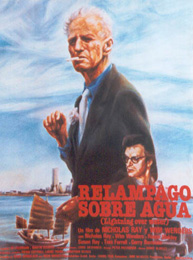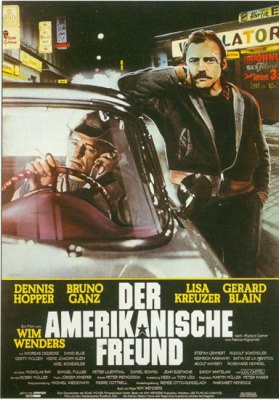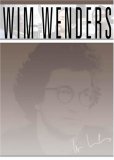| Reviews & Columns |
|
Reviews DVD TV on DVD Blu-ray 4K UHD International DVDs In Theaters Reviews by Studio Video Games Features Collector Series DVDs Easter Egg Database Interviews DVD Talk Radio Feature Articles Columns Anime Talk DVD Savant Horror DVDs The M.O.D. Squad Art House HD Talk Silent DVD
|
DVD Talk Forum |
|
|
| Resources |
|
DVD Price Search Customer Service #'s RCE Info Links |
|
Columns
|
|
|
Wim Wenders (aka The Wim Wenders Collection: Volume 2)
The titles in this collection are: The Scarlet Letter (Der Scharlachrote Buchstabe, 1973), from Hawthorne's classic American Gothic; Wrong Move (Falsche Bewegung, 1975), an iconically Wendersesque road movie about a detached man's encounters with various characters including a mute acrobat and Olympic athlete; The American Friend (Der Amerikanische Freund, 1977), from Patricia Highsmith's Ripley thriller; Lightning Over Water (1980), a reflection on filmmaker Nicholas Ray's final days; Room 666 (Chambre 666, 1982), in which directors as varied as Jean-Luc Godard and Steven Speilberg mull over the future of cinema in the cramped quarters of a Cannes hotel suite; Tokyo-Ga (1985), an exploration of Ozu in a Japan nearly unrecognizable as the country that gave birth to Tokyo Story; Notebook on Cities and Clothes (Aufzeichnungen zu Kleidern und Stadten, 1989), a further examination of Japan, popular culture, and cinema through the eyes of influential designer Yohji Yamamoto; and, appropriately, A Trick of Light (Die Gebruder Skladanowsky, 1995), which finds Wenders working with film students to recreate the look of the earliest German films. If you missed the first release, this is definitely the one to get.
Ernst Wilhelm "Wim" Wenders (b. 1945) is the most enduring and accessible practitioners of the New German Cinema (also referred to as the German New Wave) movement from the 1960s-'80s that produced such talents as Rainer Werner Fassbinder, Werner Herzog, and Volker Schlondorff. These filmmakers shook up a German film industry stagnated by increasingly tired genre films (the last gasps of German-made Westerns, Dr. Mabuse and Edgar Wallace crime thrillers, for instance) with artistically ambitious works. Like the French Nouvelle Vague, these filmmakers were greatly influenced by foreign auteurs whose films were either dismissed when they were new, or were belatedly recognized outside their industries, finding favor among cineastes, including such directors as Nicholas Ray, Samuel Fuller, and Yasujiro Ozu, all of whom play an important role in Wenders' films. His movies resemble other Neu Welle works rather than the films of those foreign directors (though their influence remains clear) but, as Wenders himself has said, "All my films have as their underlying current the Americanization of Germany. I see my own films as American." In The American Friend, the title character is played by American Dennis Hooper, portions of the film were shot in New York (in the shadow of the World Trade Center, which figures prominently in Lightning Over Water as well) and more than half the film is in English.
The thread tying Wenders to his colleagues is rather nebulous because, more so than similar movements in Japan, France, and elsewhere, German filmmakers appear to have been not particularly unified in their interests beyond their common desire to shake up and revive their flagging industry. In any case their critical success was not particularly commercial - German audiences generally stayed at home and Wenders, for one, has had to finance his movies piecemeal with moneys drawn from all over the world
What makes Wim Wenders the DVD set so intriguing (and, alternately, occasionally quite frustrating) is the range of material. Those unaccustomed to Wenders and his New German Cinema-influenced style and preoccupations will find at least some of the films or parts therein impenetrable if not downright baffling. On one hand, Wenders stands almost alone among his colleagues in achieving a relatively large, not-quite mainstream audience with some of his work, notably The American Friend, Hammett (1982), Paris, Texas (1984), and Wings of Desire (1987), to name but four examples. Hollywood "names" are eager to collaborate with him, which in turn has helped enable his larger projects get made. All of Wenders' strengths are on display in these films, yet they are also accessible to all. Interspersed between these projects Wenders likes to make smaller, more personal films where sometimes it's not only unclear whether Wenders has achieved what he has set out to make, but the very point or aim of such works is frequently cloudy and interminably cryptic when not downright pretentious. As Roger Ebert writes, "[Filmmakers like Wenders] made movies you had to reach a decision about; you couldn't just sit there and let them massage you."
This reviewer had seen Wenders' more famous films but not the smaller, more intimate ones when Tokyo-Ga was screened at the Goethe-Institut in Los Angeles some years ago. Expecting a mainstream documentary about Japanese filmmaker Yasujiro Ozu, I was bemused by the strange integration of fairly straightforward material of monologues by Ozu collaborators like actor Chishu Ryu with disconnected, seemingly random footage of amateur golfers on a driving range and a visit to a plastic food factory. After experiencing for the first time the more obscure titles in this collection I'm still not particularly fond of Tokyo-Ga, but its interests are very much in keeping with its director's: his fascination with urban landscapes, with the infusion of American popular culture in other countries, issues of identity and a generally existential approach to characters that dominate over story.
Lightning Over Water is likewise misleadingly referred to as a filmmaker documentary, this one on American director Nicholas Ray. By the time this was filmed in 1979, Ray was living in a Soho loft dying of cancer while collaborating with Wenders on a vague, unformed final film. In fact most of the film is clearly staged: Wenders' arrival in New York, his discussions with Ray about what their film should be, the German director's concerns that he might be attracted to Ray's emaciated existence*, all of which is extenuated by the presence of a film-within-the-film, a second camera videotaping the crew filming Wenders and Ray.
There are scenes from Ray's excellent The Lusty Men (1952) with Robert Mitchum (Ray's other credits include In a Lonely Place, On Dangerous Ground, Johnny Guitar, and Rebel without a Cause; his Hollywood career abruptly ended when he suffered a heart attack on 1963's 55 Days in Peking) and We Can't Go Home Again (1976), a schizophrenic, final work made on a shoestring budget and stylistically similar to Welles' unfinished The Other Side of the Wind, but most of the film has the chain-smoking Ray and Wenders acting out conversations of cryptic intentions.
Carlos James Chamberlin in his interesting essay on Ray, Regarding Bitter Victory: Hollywood's Philoctetes in the Desert or La Politique des Comediens argues the film is the "final narratization of the ultimate weakness: death. Wenders utters a line about being concerned that he is attracted to his (Ray's) weakness, that he's exploiting it. I hereby wager 1 million recycled deutschmarks that the line is Ray's. The plot of the film is the story of an actor (Ray) controlling the director (Wenders) through the brilliant use of his weakness. Wenders' benign sadism, the sadism of all directors who have to get the shot, is his performance. Lightning over Water is a film about the power and attraction of weakness. That's what the "cut – don't cut" scene is about, a final confirmation that in Nick Ray's life and work (the relation is beyond metaphorical) the wound is the bow."
These not-exactly-documentaries are interspersed in this collection with comparatively straight narrative works including, rather surprisingly, an adaptation of Nathaniel Hawthorne's The Scarlet Letter, Wenders' second feature. It's generally regarded as one of Wenders' weakest films; partly this is because the troubled production's financing buckled at the last-minute, and compromises were made in terms of casting and locations. (Wenders wanted to film it near the story's setting, in New England, but was forced to shoot on the Spanish coast.) That said, the film is quite good, evoking its oppressive 17th century Puritan community quite vividly, and the performances by Senta Berger (as the disgraced Hester), Lou Castel (as the Rev. Dimmesdale, Hester's secret lover), and especially Hans Christian Blech (as Hester's long-lost husband) are excellent.
Much of the film's success can be attributed to the superb cinematography of Robby Muller, Wenders' longtime collaborator on nearly 20 films (most recently 1999's Buena Vista Social Club) and whose recent work apart from Wenders includes 24 Hour Party People and Dancer in the Dark.
Unquestionably the best-known film of the set is The American Friend, an adaptation of Patricia Highsmith's novel Ripley's Game, with Dennis Hopper playing the same character essayed by Alain Delon in Purple Noon (Plein Soleil) and, more recently, Matt Damon in The Talented Mr. Ripley and John Malkovich in Ripley's Game, the 2002 remake. Wenders film is the one of the best films of 1970s, a superb work that plays to the director's strengths while allowing him to drawn appropriate inspiration from noir and pulp genre heroes like Ray and Fuller, both of whom appear in the film in supporting parts. (Ray plays an eccentric art forger - having faked his own suicide, he is an artist "forging" his own work - in scenes apparently filmed in the same loft used in Lightning Over Water.)
The story of a quiet family man, Jonathan Zimmerman (Bruno Ganz), manipulated into believing that his chronic blood disease has turned fatal, and thus is compelled to accept an offer to murder two men so that he can provide for his wife and son's future, The American Friend is a beautifully-realized character study awash in stunning, hypnotic images aglow in primary colors (including one great scene with sociopath Ripley laying prostrate atop a pool table's cool green illumination, taking Polaroids) and which contrast the urban decay of seaside Hamburg and Lower Manhattan with austere, post-modern Paris.
At its heart though, Wenders is concerned with the irony of Zimmerman's actions, that his selfless actions to provide for his family by committing the most reprehensible of crimes inverts itself, with Zimmerman finding a perverse fascination in the act (and subsequent affinity with fellow murderer Ripley) that in turn destroys him and his family. Amid these more humanist concerns, Wenders can fittingly incorporate his own interests in American popular culture, seen in Ripley's Hamburg residence with its Wurlitzer juke box and white Thunderbird convertible parked outside, Zimmerman's passion for rock'n'roll and pre-cinema inventions expressing movement (Zoetropes, and the like), and the film's constant but never intrusive references to postwar American cinema.
Video & Audio
With the exception of a strange transfer issue involving The Scarlet Letter, the top-drawer transfers in Wim Wenders are consistently stunning, doing justice to Wenders' and his cinematographers' mostly outstanding work. All the titles released widescreen theatrically have been 16:9 enhanced to 1.77:1, presumably under the direct supervision of Wenders and drawn from original negatives based on their extreme clarity and vibrancy of their color. Several films have also been remixed from (for the most part) their original mono. These remixes generally bring music tracks to full stereo with little, if any in the way of directional dialogue and sound effects, though the scores on such films as The American Friend (which offers tracks in both a Dolby Digital 5.1 and 2.0) are greatly enhanced.
While as gorgeous to look at as the other titles in this collection, The Scarlet Letter has a strange, distracting transferring flaw this reviewer has never seen before. Throughout the film, the heads and tails of selected shots have "double-printed" frames. It's not clear if this was inherent in the film or, more likely, was done in the transfer process or what the purpose of this was, perhaps an effort to correct a PAL-to-NTSC transfer?
The discs are all labeled Region 1, but apparently The American Friend, Lightning Over Water, and Notebook on Cities and Clothes, all part of Anchor Bay's first Wenders release, are actually region-free. The English subtitles are optional.
Extra Features
Supplements include engrossing Audio Commentaries on all the films (and deleted scenes on Notebook and The American Friend) by Wenders, speaking English throughout, who's joined by Dennis Hooper for the latter title.
Lightning Over Water includes a 38-minute featurette, Nicholas Ray: Especially for Pierre which draws on murkily videotaped but invaluable lecture footage of an ailing Ray. The American Friend includes good text bios of Wenders, Hopper, and Bruno Ganz, and Notebook on Cities and Clothes includes another featurette, Twelve Years Later.
A critical supplement is the 14-page, full-color booklet that comes with the set. Included are concise, two-page essays on each film by the Independent Weekly's Godfrey Cheshire that put each film into perspective.
About the only thing missing are trailers; only The American Friend includes ones. It would be particularly interesting to see how Wenders' earlier films were marketed both in America and Germany.
Parting Thoughts
The cinema of Wim Wenders is, as the cliche goes, an acquired taste. Even among the master filmmakers, very few have been able to juggle such a wide range of projects as Wenders has, and this has left audiences who liked Wings of Desire nonplussed by the likes of Wrong Move and Lightning Over Water, while for others Wenders has unlocked the door to newfound areas of world cinema. Wim Wenders the boxed set offers films that are alternately hypnotic, enigmatic, infuriating, frustrating, and it's an absolute must-have. A DVD Talk Collector Series title.
* When Wenders films Ray at the hospital, an off-camera television is heard reporting the news of John Wayne's own terminal cancer; they died on opposite coasts just five days apart.
Film historian Stuart Galbraith IV's most recent essays appear in Criterion's new three-disc Seven Samurai DVD and BCI Eclipse's The Quiet Duel.
|
| Popular Reviews |
| Sponsored Links |
|
|
| Sponsored Links |
|
|
| Release List | Reviews | Shop | Newsletter | Forum | DVD Giveaways | Blu-Ray | Advertise |
|
Copyright 2024 DVDTalk.com All Rights Reserved. Legal Info, Privacy Policy, Terms of Use,
Manage Preferences,
Your Privacy Choices | |||||||
















